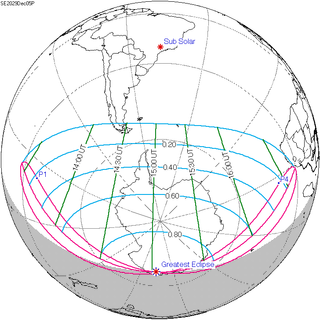
Summary
A partial solar eclipse will occur on Wednesday, December 5, 2029. A solar eclipse occurs when the Moon passes between Earth and the Sun, thereby totally or partly obscuring the image of the Sun for a viewer on Earth. A partial solar eclipse occurs in the polar regions of the Earth when the center of the Moon's shadow misses the Earth.
| Solar eclipse of December 5, 2029 | |
|---|---|
 Map | |
| Type of eclipse | |
| Nature | Partial |
| Gamma | −1.0609 |
| Magnitude | 0.8911 |
| Maximum eclipse | |
| Coordinates | 67°30′S 135°42′E / 67.5°S 135.7°E |
| Times (UTC) | |
| Greatest eclipse | 15:03:58 |
| References | |
| Saros | 123 (54 of 70) |
| Catalog # (SE5000) | 9574 |
Images edit
Animated path
Related eclipses edit
Solar eclipses 2029–2032 edit
This eclipse is a member of a semester series. An eclipse in a semester series of solar eclipses repeats approximately every 177 days and 4 hours (a semester) at alternating nodes of the Moon's orbit.[1]
Note: Partial solar eclipses on January 14, 2029 and July 11, 2029 occur on the previous lunar year eclipse set.
| Solar eclipse series sets from 2029 to 2032 | ||||
|---|---|---|---|---|
| Descending node | Ascending node | |||
| 118 | June 12, 2029 Partial |
123 | December 5, 2029 Partial | |
| 128 | June 1, 2030 Annular |
133 | November 25, 2030 Total | |
| 138 | May 21, 2031 Annular |
143 | November 14, 2031 Hybrid | |
| 148 | May 9, 2032 Annular |
153 | November 3, 2032 Partial | |
Metonic series edit
The metonic series repeats eclipses every 19 years (6939.69 days), lasting about 5 cycles. Eclipses occur in nearly the same calendar date. In addition, the octon subseries repeats 1/5 of that or every 3.8 years (1387.94 days). All eclipses in this table occur at the Moon's ascending node.
| 21 eclipse events, progressing from south to north between July 13, 2018 and July 12, 2094 | ||||
|---|---|---|---|---|
| July 12–13 | April 30-May 1 | February 16–17 | December 5–6 | September 22–23 |
| 117 | 119 | 121 | 123 | 125 |
| July 13, 2018 |
April 30, 2022 |
February 17, 2026 |
December 5, 2029 |
September 23, 2033 |
| 127 | 129 | 131 | 133 | 135 |
| July 13, 2037 |
April 30, 2041 |
February 16, 2045 |
December 5, 2048 |
September 22, 2052 |
| 137 | 139 | 141 | 143 | 145 |
| July 12, 2056 |
April 30, 2060 |
February 17, 2064 |
December 6, 2067 |
September 23, 2071 |
| 147 | 149 | 151 | 153 | 155 |
| July 13, 2075 |
May 1, 2079 |
February 16, 2083 |
December 6, 2086 |
September 23, 2090 |
| 157 | ||||
| July 12, 2094 | ||||
References edit
- ^ van Gent, R.H. "Solar- and Lunar-Eclipse Predictions from Antiquity to the Present". A Catalogue of Eclipse Cycles. Utrecht University. Retrieved 6 October 2018.
External links edit
- Earth visibility chart and eclipse statistics Eclipse Predictions by Fred Espenak, NASA/GSFC
- Google interactive map
- Besselian elements


